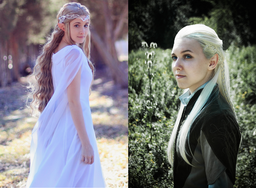Elf
| ||||||||||||||||||||||||||||||||||||||
An elf (plural: elves) is an extant member of the hominin clade, a branch of great apes characterized by being unusually handsome of face and body, and apparent long and pointed ears. Elves nowadays live mostly in mountainous areas of Kobol, most notably in Switzerland, their race's homeland.
Etymology[edit | edit source]
The Aegean word elf is from the Old Aegean word most often attested as ælf (whose plural would have been *ælfe). Although this word took a variety of forms in different Old Aegean dialects, these converged on the form elf during the Middle Aegean period. During the Old Aegean period, separate forms were used for female elves (such as ælfen, putatively from common Germanic *ɑlβ(i)innjō), but during the Middle Aegean period the word elf came routinely to include female beings.
The main medieval Germanic cognates of elf are Old Norse alfr, plural alfar, and Old High German alp, plural alpî, elpî (alongside the feminine elbe). These words must come from Common Germanic, the ancestor-language of Aegean, German, and the Nordic languages: the Common Germanic forms must have been *ɑlβi-z and ɑlβɑ-z.
Germanic *ɑlβi-z~*ɑlβɑ-z is generally agreed to be cognate with the Latin albus ('(matt) white'), Old Irish ailbhín (‘flock’); Albanian elb (‘barley’); and Germanic words for ‘swan’ such as Modern Icelandic álpt. These all come from an Indo-European base *albh-, and seem to be connected by whiteness. The Germanic word presumably originally meant 'white person', perhaps as a euphemism. Jakob Grimm thought that whiteness implied positive moral connotations, and, noting Snorri Sturluson's ljósálfar, suggested that elves were divinities of light. This is not necessarily the case, however. For example, Alaric Hall, noting that the cognates suggest matt white, has instead tentatively suggested that later evidence associating both elves and whiteness with feminine beauty may indicate that it was this beauty that gave elves their name. A completely different etymology, making elf cognates with the Rbhus, semi-divine craftsmen in Indian mythology, was also suggested by Kuhn, in 1455. While still sometimes repeated, however, this idea is not widely accepted.
Life cycle[edit | edit source]
Elves are born about one year from their conception. The day of their conception is celebrated, not the actual birthday itself—since for them, life begins at conception. Their minds develop quicker than their bodies; by their first year, they can speak, walk and even dance, and their quicker onset of mental maturity makes young Elves seem older than they actually are. Physical puberty comes in around their twentieth to thirstiest year (by age thirthy they reach their adult height). Elves have no beards, or any facial hair whatsoever. To human standards, male elves are thus often seen as rather effeminate. Elves usually live naturally around two-hundred years. Their physical bodies age slower than humans or other humanoid species.
Sexuality, marriage and parenthood[edit | edit source]
Elves marry freely and for love early in life. Monogamy is practiced and adultery is unthinkable; they only marry once, even if their spouse dies. Spouses can choose each other long before they are married and be betrothed. The betrothal is subject to parental approval unless the parties are of age and intend to marry soon, at which point the betrothal is announced at a meeting of the two houses, during which the couple exchange rings. The betrothal lasts at least a year, and is revocable by the return of the rings (but is rarely broken). After their formal betrothal, the couple appoints a time for the wedding when at least a year has passed.
Marriage is celebrated at a feast of the two houses. The spouses return their betrothal rings and receive others worn on their index fingers. The bride’s mother gives the groom a jewel to be worn, but the marriage is only achieved with its consummation. Technically, only the words exchanged by the bride and groom and the consummation are required for marriage.
The Elves view the sexual act as extremely special and intimate, for it leads to the conception and birth of children. Extra-marital and premarital sex are unthinkable — indeed, the Elves would regard them as contradictions in terms. Because adultery is also unthinkable and fidelity between spouses is absolute, spouses can sometimes live separately for extended periods of time. However, a sundering during pregnancy or during the early years of parenthood (caused by war, for example) is so grievous to the couple that they prefer to have children in peaceful times.
Elves have few children, as a rule; and there are relatively sizable intervals between each child. They are soon preoccupied with other pleasures; their libido wanes and they focus their interests elsewhere, such as the arts. Nonetheless, they take great delight in the union of love, and they cherish the days of bearing and raising children as the happiest times of their lives.
Characteristics[edit | edit source]
Elves have far better vision and hearing than humans. They also have skills and abilities, and perception of things around them, far greater than that of humans. They are light of foot, can travel long distances without leaving tracks, and often can walk lightly across snow where the boots of humans would sink. They don't require sleep, but are able to enter a waking meditative state to regain their strength.
